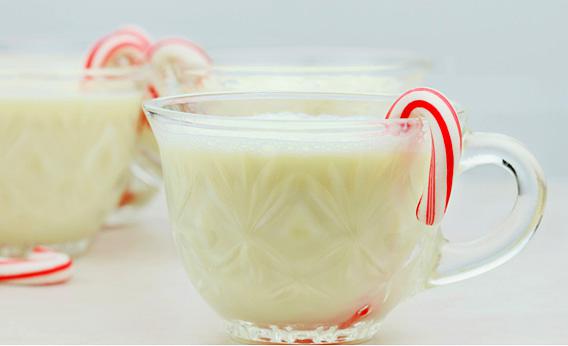Sales of eggnog have quadrupled in the last 50 years, yet eggnog is widely available only two months out of the year. Noted libertarian Homer J. Simpson blames the government for its sudden disappearance. Why don’t dairy manufacturers make eggnog all year long?
It doesn’t sell. Demand for eggnog follows traditional consumption patterns that date back hundreds of years. The drink was a wintertime favorite of the British aristocracy, who took it warm, mixed with brandy or sherry to prevent spoilage. Eventually eggnog became popular with American colonists, who replaced the expensive liquors with more readily available rum. By the 1800s it was commonly served at winter holiday parties, and it has retained its Christmastime flavor ever since.
For today’s manufacturers, eggnog season begins in the last half of October, but the exact start date varies by region, as individual plants decide when to ramp up production. Meadow Gold, sold in the western half of the country, sometimes starts as early as mid-September. Every plant is at full bore by November.
Sales slowly but steadily increase until they reach a peak during Thanksgiving week, which tends to produce more than 10 percent of annual revenue. After Thanksgiving, demand dips slightly, but quickly picks up again, cresting at the end of December—about 20 percent of the yearly sales come during the week leading up to Christmas. After that, demand drops precipitously: The next week sees about half as many sales. Most plants keep producing eggnog through New Year’s, and start dumping their unsold product in January.
Although associated with the holidays, eggnog doesn’t need to be seasonal. Dairy plants could produce small batches of eggnog off-season for hard-core nogheads, but they don’t because it’s not cost-effective. Even a small run involves processing the ingredients, cleaning the machinery out, and updating the labels and packaging. It also takes up space on delivery trucks, and grocers need to figure out where to put it in on the shelves. In other words, off-season eggnog is a big hassle, and would appropriate resources from products that dairy makers know will sell—for example, white milk and chocolate milk, which have consistent demand throughout the year.
There is a secondary predictor of eggnog demand: the weather. Manufacturers have noticed that the colder it is, the more eggnog people buy. Eggnog sells much better in cooler climates—the Midwest and Northeast, for example—than in the warmer climates of the South. Dean Foods, which makes about one-third of the 130 million pounds of eggnog sold each year in the United States, says that its three most popular brands are all sold in the northernmost climates of the country. And even within a particular cold-climate market, dairy makers say that sales plunge when the mercury rises.
In spite of all the above, some dairy plants actually do produce eggnog outside of the traditional holiday season. Since the 1990s, Dean Foods has produced an Easter-themed eggnog in a few markets leading up to the springtime holiday. It turns a small profit, but Easter ’nog never sells as well as the more common Christmas variety, and makes up only a few percent of the total yearly sales.
Got a question about today’s news? Ask the Explainer.
Explainer thanks Sarah Barow of HP Hood, Frederick Douglass Opie of Babson College, and Jamaison Schuler of Dean Foods.
